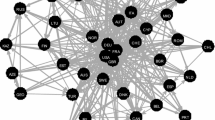Abstract
By analyzing the 64 countries that represent the largest number ofinternational student exchanges, this article describes internationalstudent flows from a macro perspective. The findings indicate that theinternational student exchange network remained relatively stable. TheUnited States and most Western industrialized countries maintained theirposition at the center of the network, while East European and Asiancountries have become more central and the African and Middle Eastcountries have stayed peripheral. The results suggest an academichegemony consistent with world economic and political performance. Alliedwith World System Theory, the higher a country's position in the worldsystem, the more central it is in the international student exchangenetwork.
Similar content being viewed by others
References
Altbach, P.G., Kelly, D.H. and Lulat, Y.G. (1985). Research on Foreign Students and International Study: An Overview and Bibliography. New York: Praeger.
Barnett, G.A. and Danowski, J.A. (1992). 'The structure of communication: A network analysis of the international communication association', Human Communication Research 19(2), 264–285.
Barnett, G.A., Danowski, J.A. and Richards, W.D. (1993). ‘Communication networks and network analysis. A current assessment’, in Richards and Barnett (eds.), Advanced in Communication Science, Vol. 12. Norwood NJ: Ablex, pp. 1–20.
Barnett, G.A. and Doerful, M.C. (1997). 'A semantic network analysis of the international communicatgion association', Paper Presented at the annual Meeting of the International Communication Association. Montreal, Quebec, May.
Barnett, G.A., Jacobson, T., Choi, Y. and Sun, S. (1996). 'An examination of the international telecommunications network', Journal of International Communication 3, 19–43.
Barnett, G.A. and Salisbury, J.G.T. (1996). 'Communication and globalization: A longitudinal analysis of the international telecommunication network', Journal of World-System Research 2(16), 1–17.
Barnett, G.A., Salisbury, J.G.T., Kim, C.W. and Langhorne, A. (1997). 'Globalization and international communication: An examination of monetary, telecommunication, and trade networks', Paper Submitted to the International Communication Association's Annual Conference. Jerusalem, Israel, May, 1998.
Barnett, G.A. and Wu, R.Y. (1995). 'The international student exchange network: 1970 and 1989', Higher Education 30, 353–368.
Bollag, B. (1994). 'European Union to open exchanges to universities in the east', The Chronicle of Higher Education 41(2), 62.
Bradshaw, Y. (1991). 'Intensifying global dependency: Foreign debt, structural adjustment, and third world underdevelopment', Sociological Quarterly 32, 321–342.
Chase-Dunn, C. (1989). Global Formation: Structures of the World-Economy. London: Basil Blackwell.
Clark, D. and Merrit, R. (1982). 'World-System theory', Annual Review of Sociology 8, 106.
Cummings, W.K. (1993). 'Global trends in overseas study', in Goodwin, C.D. (eds.), International Investment in Human Capital: Overseas Education for Development. New York: Institute of International Education, pp. 9–30.
McMahon, M.E. (1992). 'Higher education in a world market: An historical look at the global context of international study', Higher Education 24, 465–482.
Mitchell, J. (1974). 'Social network', Annual Review of Anthropology 3, 279–299.
Richards, W.D. (1995). NEGOPY 4.30: Manual and User's Guide. Canada: Simon Fraser University.
Rogers, E.M. and Kincaid, D.L. (1981). Communication Network: Toward a New Paradigm for Research. New York: Free Press.
Shannon, T.R. (1989). World System Perspective. San Francisco: Westview Press.
Smith, D. and Nemeth, R. (1988). 'An empirical analysis of commodity exchange in the international economy: 1965-80', International Studies Quarterly 32, 227–240.
Sun, S. and Barnett, G.A. (1994). 'An analysis of the international telephone network and democratization', Journal of the American Society for Information Science 45, 411–421.
Sutton, D.A. and White, D.R. (1992). 'Structure and dynamics of the global economy: Network analysis of international trade 1965-1980', Social Forces 70(4), 857–893.
Sutton, F.X. (1993). 'The world in 1990s', in Goodwin, C.D. (ed.), International Investment in Human Capital: Overseas Education for Development. New York: Institute.
UNESCO Statistical Yearbook (1987, 1991, 1997). Paris: Author.
Wimberley, D. (1990). 'Investment dependence and alternative explanations of third world mortality: A cross-national study', American Sociological Reviews 55, 75–91.
World Development Report (1987, 1991, 1997). Published for the World Bank. Oxford: Oxford University Press.
Author information
Authors and Affiliations
Rights and permissions
About this article
Cite this article
Chen, TM., Barnett, G.A. Research on international student flows from a macro perspective: A network analysis of 1985, 1989 and 1995. Higher Education 39, 435–453 (2000). https://doi.org/10.1023/A:1003961327009
Issue Date:
DOI: https://doi.org/10.1023/A:1003961327009




